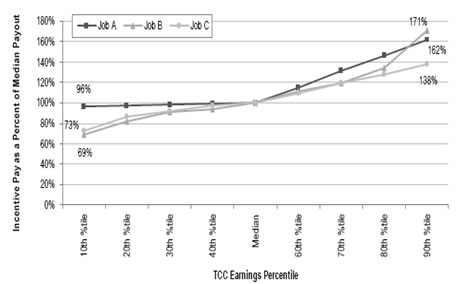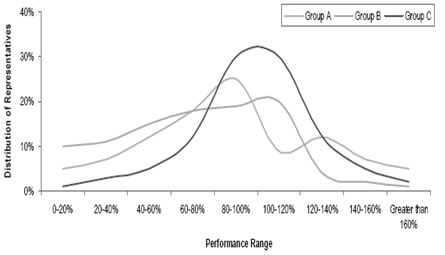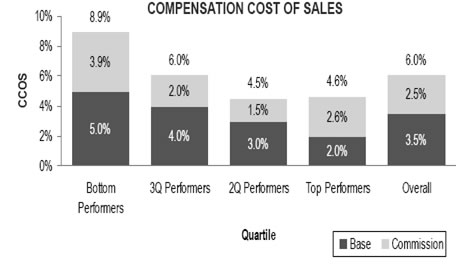DiMisa, who is Senior Vice President, Sales Force Effectiveness at Sibson Consulting, is author of best-selling business book, The Fisherman’s Guide to Selling. He offered his tips during a recent webinar sponsored by BLR and HR Hero.
DiMisa suggests compensation pros look at the following metrics:
- PAR Analysis: Analysis of churn, penetration and acquisition
- Pay Differentiation: Ratio of incentive pay to the median
- Average Pay Composition: Pay composition by component
- Performance Distributions: Histogram of sales rep performance by a given metric
- Compensation Cost of Sales: Total compensation (Base Pay + Commissions) for full year reps/corresponding annualized revenue
PAR Analysis
- Examines how an organization grows its revenue-by Penetration, Acquisition and/or Retention
- Can be performed at the organization, region and/or representative level
- Ensures that revenue generation is consistent with strategic goals
|
$90K |
|||||
|
$80K |
|||||
|
$70K |
Churn |
||||
|
$60K |
|||||
|
$50K |
|||||
|
$40K |
|||||
|
$30K |
|||||
|
$20K |
|||||
|
$10K |
|||||
|
Last year’s revenue |
Retention |
Penetration |
Acquisition |
This year’s revenue |
Expressed as a formula, the PAR analysis is:
|
R |
+ |
P |
+ |
A |
= |
G |
|
Revenue Retained from Existing Customers |
|
Increased from Revenue Existing Customers |
|
Revenue from New Markets or Prospects |
|
Revenue |
What to look for:
- A significant increase in the amount of churn may indicate a shift in rep focus on new business over retention of old, which may indicate the plan is focusing effort away from retaining key clients.
- The compensation plan should be consistent with strategic objectives for how revenue is generated at the organization. For example, if focus is on acquisition of new business, acquisition percentage should increase and the compensation plan should encourage hunter behavior.
Step … away … from the keyboard! More than 700 prewritten, legally reviewed job descriptions ready at the click of your mouse. Use as is—or easily modify, save, and print. Pay grades are already attached. Try BLR’s remarkable SmartJobs program at no cost. Click here to learn more.
Performance Differentiation Analysis
- Examines how much representatives earn at different performance levels.
- Can be performed for subpopulations (e.g., tenure, region, or job role groupings) and/or for the organization as a whole.
- Should verify that pay and performance are both differentiated and aligned for populations.

What to look for:
- Confirm a reasonable difference between top performers and the median in order to compensate for excellence.
- Confirm a reasonable difference between low performers and the median so that they are motivated to work harder rather than become complacent. In the chart above we can see that there is little incentive for poor performers in Job A.
Average Pay Composition analysis
- Assesses the composition of compensation by plan component to illustrate how representatives earn incentive dollars.
- Can be performed for subpopulations (i.e., tenure, region or job role groupings) and/or for the organization as a whole.
- Helps plan administrators to monitor whether payouts are in line with those desired.

What to look for:
- Significant differences between actual pay and target show potential problem areas.
- It may be necessary to delve deeper to determine why discrepancies occur.
Most disliked chore checked off! More than 700 prewritten, legally reviewed job descriptions are ready to go at the click of your mouse. Use as is—or easily modify, save, and print. Pay grades already attached. Try BLR’s remarkable SmartJobs program at no cost.
Performance Distribution Analysis
- Analyzes performance of sales representatives by isolating representatives according to different performance level groupings.
- Can be performed for subpopulations (i.e., tenure, region or job role groupings) and/or for the organization as a whole.
- Helps determine the number of representatives at, above or below target performance.
- Ideally, graph should look like a bell curve with the peak over target performance.

What to look for:
- Uneven distributions of representatives or “bunching” around certain performance groupings may mean that quota allocation is misaligned with market opportunity
- Other causes for uneven distribution may be unexpected market variations or performance penalties built into the plan
CCOS (Compensation Cost of Sales) Analysis
- Provides the most accurate measure of a plan’s total cost.
- Sum the desired element of compensation for a population and divide by sum of all credited revenue generated by same population (you can choose the entire population or a subpopulation, e.g., tenure or geographic grouping).
- CCOS can be influenced by product margins, volume deal size, business maturity, revenue crediting and pay philosophy.
- Confirms that the plan is operating appropriately according to an organization’s nature and needs.
- Note that this analysis can be broken out by base salary, incentive compensation and/or total compensation.

What to look for:
- CCOS should be consistent with corporate goals and aligned with industry standards.
- Period-to-period and subpopulation-to-subpopulation comparisons should also be relatively consistent; spikes or swings in CCOS indicate that over- or under-payment is taking place.
- Watch to ensure that VCOS aligns with your targets. If you see wide swings from one quartile to the next, you may be under- or over-paying these reps.
- In a plan with consistent performance, you will see less variability in the base cost of sales. You may wish to examine this analysis to evaluate quota setting efforts, training results, etc.
In tomorrow’s Advisor, more of Dimisa’s tips for comp managers, plus great news—your job descriptions are updated and ready to go, in BLR’s SmartJobs.

1 thought on “5 Real-World Sales Comp Metrics”